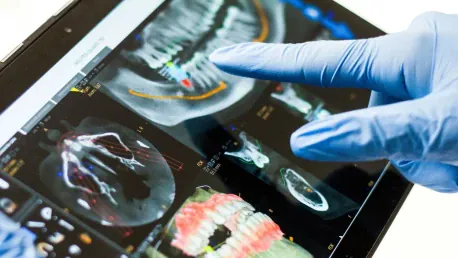The North American Cone-Beam Computed Tomography (CBCT) dental imaging market has been rapidly evolving, driven by groundbreaking technological advancements and increasing demands for precision in dental procedures. As predictions suggest, by 2024, this market’s value could exceed USD 1.05 billion. But what does this mean for the future of precision dentistry?
Drivers of Technological Adoption
Rising Demand for Dental Implants
Statistics from the American Academy of Implant Dentistry indicate that over 3 million Americans have dental implants, with around 500,000 new implants added annually. CBCT imaging has become indispensable in pre-surgical planning, ensuring precise placement and reducing procedural risks. This growing demand for implants is driven not only by aesthetics but also by the need for improved functionality in oral health. CBCT significantly aids in visualizing the anatomical structures of the teeth and jaw, thereby providing a clear roadmap for implant placement and reducing the likelihood of complications. With the aging population expected to constitute a considerable portion of the U.S. demographic, the need for dental implants—and consequently CBCT imaging—is poised to rise exponentially.
Furthermore, CBCT imaging has exhibited a remarkable success rate of over 97% in implant surgeries due to its precision and ability to minimize risks, boasting improved patient outcomes. Its application extends beyond implant dentistry, with orthodontics, endodontics, and maxillofacial surgeries leveraging this technology for superior diagnostic accuracy. CBCT imaging’s high-resolution, three-dimensional views facilitate comprehensive treatment planning, alignments, and therapeutic interventions, underscoring its indispensable role in modern dental practices.
Advancements in Imaging Technologies
The incorporation of AI-powered image processing and cloud-based data storage has revolutionized imaging data management in dentistry. Innovations such as Carestream Dental’s SmartPad and seamless integration with Electronic Health Record (EHR) systems are amplifying diagnostic precision. These technologies ensure that dental professionals can access, share, and analyze imaging data more efficiently, thereby optimizing patient care. For instance, AI algorithms can enhance image clarity, automatically identify anomalies, and provide data-driven insights, which significantly reduce diagnostic errors and improve treatment outcomes.
Moreover, cloud-based data storage solutions facilitate the seamless and secure sharing of imaging files across platforms and practices, ensuring collaborative care and comprehensive treatment planning. With over 90% of U.S. hospitals adopting EHRs, the integration of CBCT systems within these digital frameworks further amplifies workflow efficiency and enhances diagnostic precision. Innovations in CBCT technology are also focusing on reducing radiation exposure and improving image quality, ensuring safer and more effective diagnostic tools. The advent of portable and compact CBCT systems is expanding accessibility, allowing for broader adoption across diverse clinical settings, including smaller practices and rural areas.
Market Challenges
High Costs and Financial Barriers
CBCT systems are notably expensive, with prices ranging from USD 80,000 to USD 150,000. These high costs present a substantial barrier for smaller dental practices, particularly those located in rural areas, limiting widespread market penetration. The financial burden associated with acquiring and maintaining these advanced imaging systems often discourages smaller and independent practices from investing in CBCT technology. Additionally, many insurance policies do not cover CBCT imaging procedures, exacerbating the financial strain on both providers and patients.
The lack of adequate reimbursement policies remains a significant hurdle, as only 20% of dental insurance policies offer coverage for advanced imaging. This insufficiency in reimbursement imposes a substantial financial burden on patients, especially those from low-income groups, hampering access to preventive care and early disease detection. Addressing these financial constraints and ensuring better insurance coverage are critical for fostering equitable distribution of CBCT benefits and supporting widespread adoption across various dental practices.
Concerns Over Radiation Exposure
Despite CBCT’s lower radiation levels compared to traditional CT scans, concerns about exposure persist within both the dental community and among patients. While CBCT imaging provides substantial benefits in terms of diagnostic accuracy and detailed anatomical visualization, maintaining safety standards is paramount. Regulatory guidelines from bodies such as the FDA emphasize the importance of safe usage practices to mitigate radiation risks and safeguard patient trust in the technology.
Radiation exposure concerns necessitate rigorous adherence to safety protocols and continuous monitoring to ensure optimal usage. Education on safe imaging practices and advances in technology aimed at reducing radiation dose are essential for addressing these concerns. Innovations in CBCT systems focusing on dose optimization and enhanced shielding features are pivotal in promoting safer imaging practices. As the dental community continues to adopt CBCT technology, prioritizing patient safety while leveraging its diagnostic advantages remains indispensable.
Opportunities for Market Growth
The Rise of Teledentistry
Teledentistry has skyrocketed, becoming 38 times more popular post-pandemic. Dentists can now share CBCT images remotely, profoundly improving collaborative care and accessibility. Platforms like Dentsply Sirona’s Sidexis Cloud have streamlined the process, reducing patient travel costs and enhancing service delivery. This expanding adoption of teledentistry is transforming how dental care is administered, allowing for real-time consultations, remote diagnostics, and follow-up care.
Teledentistry enables dental professionals to provide consistent and continuous care to patients, irrespective of geographic constraints. As remote consultations become more prevalent, collaborating on diagnostic data and treatment plans through CBCT imaging becomes crucial. The ability to access high-quality imaging data remotely supports comprehensive assessments and timely interventions, ultimately improving patient outcomes. Moreover, the integration of teledentistry with CBCT systems democratizes access to expert care, providing patients with specialized diagnostic services without necessitating physical visits.
Dental Tourism Boost
International patients flocking to North America for affordable, high-quality dental care have spurred market expansion. Countries like the U.S. and Mexico report significant increases in foreign patients seeking treatments facilitated by CBCT imaging. The influx of international patients seeking cost-effective dental procedures, particularly those requiring precision diagnostics and interventions, is enhancing the region’s market dynamics.
Dental tourism is bolstered by North America’s robust healthcare infrastructure and advancements in diagnostic technologies, positioning it as a preferred destination for quality dental care. Clinics catering to international patients invest in cutting-edge CBCT systems to ensure superior diagnostic services and attract a broader clientele. The rising trend of dental tourism underscores the growing recognition of North America’s prowess in precision dentistry, fueled by technological advancements in CBCT imaging.
Exploring Market Dynamics
Detector Types and Their Relevance
Flat panel detectors lead the market due to their superior image quality and adaptability with EHR systems. These detectors offer enhanced imaging resolution and comprehensive anatomical details, making them indispensable in precision diagnostics. With the ongoing adoption of preventive care among the aging population, the dominance of this segment is expected to continue. The meticulous imaging provided by flat panel detectors facilitates accurate diagnosis and effective treatment plans, ensuring optimal oral health outcomes.
Moreover, flat panel detectors are highly compatible with digital health ecosystems, allowing seamless integration with EHR systems for efficient data management and collaborative care. As healthcare facilities increasingly adopt digitized workflows, the relevance of flat panel detectors in dental imaging is further amplified. Innovations in detector technology are continuously enhancing image quality, making them a preferred choice in modern dental practices.
Endodontic Applications on the Rise
The demand for detailed imaging in root canal treatments has spurred the growth of the endodontic segment. Root canals require precision and accuracy in diagnosing and treating infections within the tooth’s structure, necessitating advanced imaging technologies. CBCT imaging’s precision significantly reduces diagnostic errors, making it a favored choice among dental professionals. The ability to visualize intricate details of the tooth and surrounding tissues ensures comprehensive assessments and effective treatment plans.
Endodontic treatments benefit immensely from CBCT imaging, as the detailed three-dimensional views facilitate accurate measurements and identify complex anatomical variations. This precision is crucial for successful interventions, reducing the likelihood of complications and enhancing patient outcomes. As the prevalence of endodontic procedures continues to rise, the adoption of CBCT imaging is expected to see significant growth, driven by its superior diagnostic capabilities and contribution to precision dentistry.
Key Market Players and Competitive Landscape
Carestream Dental LLC
Known for its innovative approach, Carestream Dental’s products like the CS 9600 employ AI for enhanced image clarity, solidifying its market position. The integration of AI analytics within CBCT systems augments imaging capabilities, offering unparalleled precision and clarity. Carestream Dental’s focus on practitioner training and its robust distribution network further bolster its competitiveness in the market.
Carestream Dental’s commitment to advancing imaging technologies and ensuring comprehensive practitioner support underpins its leadership in the industry. By continually innovating and adapting to emerging trends, the company maintains a prominent role in driving market growth and setting industry standards.
Planmeca Oy and Sustainable Practices
Planmeca Oy stands out with its diverse imaging systems and CAD/CAM solutions, strengthened by its commitment to sustainability and ethical practices. The company’s focus on eco-friendly manufacturing processes and sustainable practices enhances its reputation in the industry. Planmeca’s advanced imaging systems provide dental professionals with cutting-edge tools, ensuring precise diagnostics and superior patient care.
The integration of CAD/CAM solutions within Planmeca’s product offerings further underscores its dedication to innovation and technological advancement. These solutions streamline workflows, improve treatment planning, and facilitate accurate diagnostic assessments, contributing to enhanced patient outcomes. Planmeca’s focus on sustainability and ethics resonates with the growing demand for responsible and innovative healthcare solutions.
Dentsply Sirona Inc.
Dentsply Sirona is celebrated for its patient-centric design and advanced diagnostic technologies, consistently making significant strides in the market. Collaborating closely with clinicians, Dentsply Sirona creates solutions tailored to user needs, ensuring practical and effective applications of CBCT systems. The company’s commitment to providing high-quality imaging tools that enhance diagnostic precision reinforces its standing in the industry.
Collaborations and partnerships play a crucial role in Dentsply Sirona’s strategy, fostering innovation and expanding its market reach. By integrating clinically informed insights into its product development processes, Dentsply Sirona ensures that its imaging solutions align with the practical needs of dental professionals, facilitating efficient and accurate diagnostic assessments.
Strategic Partnerships and Innovations
Expanding Reach and Resources
Leading companies are forging strategic partnerships, mergers, and acquisitions to expand their market reach and consolidate resources, fostering technological innovation. These strategic moves enable companies to leverage shared expertise, enhance product offerings, and broaden their customer base. By pooling resources and collaborating on research and development efforts, market leaders continue to advance CBCT imaging technology and support its widespread adoption.
Strategic partnerships also facilitate market entry into new regions and demographics, ensuring broader accessibility and uptake of advanced imaging systems. Mergers and acquisitions consolidate market presence, augment capabilities, and foster innovation, thereby driving sustained growth and development within the industry.
AI and Cloud-Based Integrations
Organizations like Carestream Dental are increasingly focusing on AI and cloud-based integrations. Partnering with tech giants such as Google Cloud enables enhanced data handling capabilities, advancing the market further. AI algorithms significantly improve image processing, providing dental professionals with advanced diagnostic tools that enhance precision and reduce errors.
Cloud-based integrations facilitate secure and efficient data management, enabling seamless sharing and collaboration on imaging files across practices and platforms. This capability is crucial for improving diagnostic workflows and ensuring comprehensive and patient-focused care. The incorporation of cloud-based systems within CBCT imaging frameworks underscores the industry’s dedication to adopting innovative technologies that drive precision dentistry forward.
Recent Developments and Future Directions
New Product Launches and Collaborations
Recent market developments include Carestream Dental’s launch of the AI-powered CS 9600 CBCT system in April 2024, and Planmeca’s introduction of ProMax 3D Classic in June 2023. These innovations continue to elevate the standards in dental imaging, presenting advanced tools for superior diagnostic capabilities. As companies introduce new products and technologies, the market witnesses continuous advancements that enhance the accuracy and effectiveness of dental imaging.
Collaborations with academic institutions and technology providers further drive innovation, ensuring ongoing research and development that bolster the market. Partnerships with universities support scientific exploration and validate emerging technologies, while collaborations with tech firms integrate cutting-edge solutions into imaging systems, driving the industry forward.
Regulatory and Financial Hurdles
The North American Cone-Beam Computed Tomography (CBCT) dental imaging market has been undergoing significant transformations due to cutting-edge technological innovations and a rising need for precision in dental procedures. This advanced technology provides detailed 3D images, allowing for more accurate diagnoses and treatment plans. The ability to visualize various angles and sections of dental structures enables dentists to enhance the quality of care they provide. Experts predict that by 2024, the market’s value could surpass USD 1.05 billion.
Such growth indicates a substantial shift towards more sophisticated dental imaging solutions that promise greater accuracy and efficiency. As these technologies continue to develop, the potential for improved patient outcomes becomes increasingly evident. High-resolution images from CBCT scanners are crucial for various applications, including implant planning, endodontics, and orthodontics.
The increasing adoption of CBCT technology also reflects a broader trend in healthcare towards personalized medicine. By harnessing the detailed imaging capabilities of CBCT, dentists can tailor treatments to the unique anatomical features of each patient, significantly improving the success rates of interventions. This move towards precision dentistry not only enhances patient care but also optimizes procedural outcomes, ultimately leading to a higher standard of dental health services across North America.









